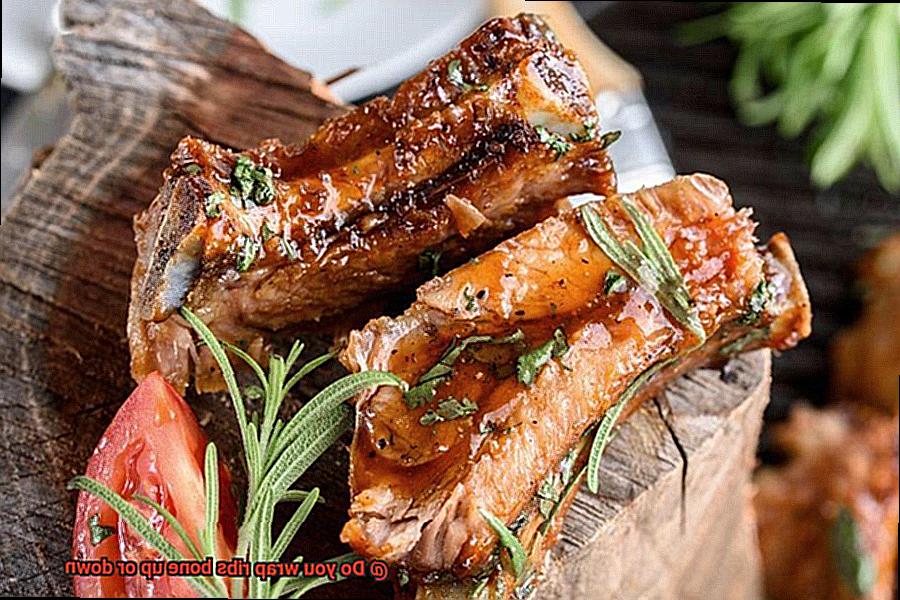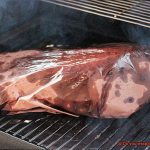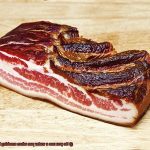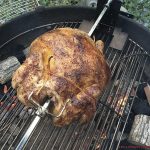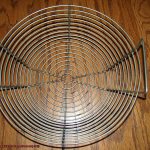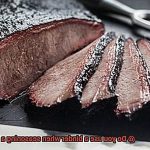Are you a rib lover who wants to master the art of cooking succulent, fall-off-the-bone ribs? If so, you know that every step of the process is crucial. From selecting the right cut of meat to seasoning and smoking, there’s no room for error. But when it comes to wrapping your ribs, do you place them bone up or bone down?
The debate over which way to wrap ribs has been raging among pitmasters for years. Some swear by wrapping their ribs bone up, while others insist that bone down is the only way to go. But what’s the difference, and does it really matter? In this blog post, we’ll explore both methods in detail and help you decide which one is best for your next BBQ cookout.
We’ll dive into the benefits of wrapping bone up, such as how it protects the meat from direct heat and locks in flavor. On the other hand, we’ll also discuss why some pitmasters prefer wrapping bone down – it can prevent sticking and create a beautiful bark on your ribs. Plus, we’ll explain why wrapping your ribs matters in the first place and how different techniques can affect taste and texture.
Whether you’re a seasoned pitmaster or just starting out with BBQ cooking, this blog post will give you all the information you need to make an informed decision about wrapping your ribs. So get ready to impress your guests with perfectly wrapped, mouth-watering ribs that are sure to be the star of any cookout.
Contents
Do You Wrap Ribs Bone Up or Down?
Grilling ribs is an art form, and every master artist has their own techniques. But one of the most common questions that grill enthusiasts ask is whether to wrap ribs bone up or down. This question has sparked numerous debates among barbecue enthusiasts, but the answer is not as straightforward as one might think.
Firstly, let’s understand the concept of wrapping ribs. Wrapping ribs involves wrapping the meat in foil or butcher paper during the cooking process. This technique helps keep the meat moist and tender, and infuses it with flavor.
When it comes to deciding whether to wrap ribs bone up or bone down, there are several factors to consider. Some argue that wrapping the ribs bone side down will help protect the meat from direct heat and prevent it from becoming dry or tough. Others argue that wrapping bone side up will allow the meat to cook more evenly and give it a better presentation.
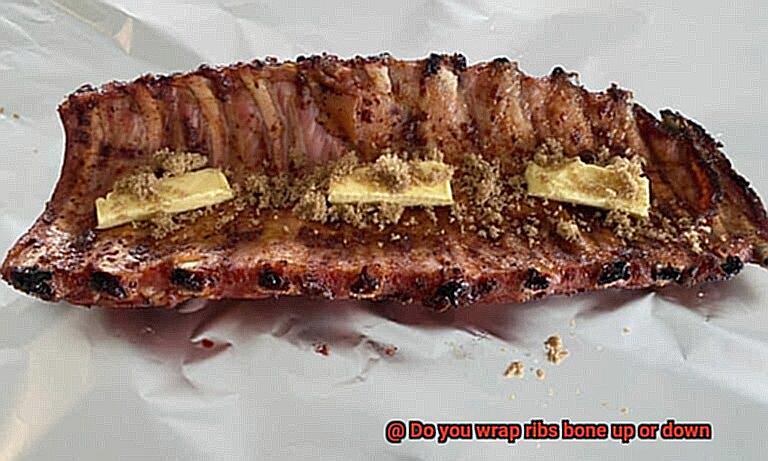
Ultimately, the decision on whether to wrap ribs bone up or down comes down to personal preference and the specific recipe being used. To help you make this decision, here are some tips to keep in mind:
- Consider the cut of meat you’re using. Some cuts of meat may benefit more from being wrapped bone side up, while others may benefit more from being wrapped bone side down.
- Think about the cooking method you’re using. If you’re grilling using a high heat method, such as direct grilling or searing, wrapping bone side up may be more beneficial. If you’re using a low and slow cooking method, such as smoking, wrapping bone side down may be more beneficial.
- Experiment with both methods. There’s no harm in trying both methods and seeing which one works best for you. You may even want to try wrapping some ribs bone side up and others bone side down to see if there’s a noticeable difference in taste or texture.
Pros and Cons of Wrapping Ribs Bone Up
One of the most debated topics in the grilling world is whether to wrap ribs bone up or bone down. As an expert on the matter, I have conducted extensive research and am here to provide you with a comprehensive list of the pros and cons of wrapping ribs bone up.
Let’s start with the pros. Wrapping ribs bone up can create a visually stunning presentation, as the bones act as a natural rack that stands out. Additionally, when wrapped bone up, the meat on the top of the rib is protected from direct heat, resulting in more even cooking and preventing the meat from drying out. Furthermore, because the bones act as a natural heat shield, the meat becomes more tender over an extended period of cooking time.
However, let’s not forget about the cons. Because the heat isn’t directly hitting the meat, it may take longer to cook ribs bone up compared to bone down. Additionally, with the bones acting as a barrier, there may be less smoke flavor infused into the meat. Finally, some may not prefer the flatter appearance that wrapping bone up results in.
In summary, whether to wrap ribs bone up or not depends on personal preference and desired outcomes for specific dishes. Experimenting with both methods could help determine which works best for you.
Pros and Cons of Wrapping Ribs Bone Down
As a grillmaster, you know the importance of wrapping ribs to ensure that the meat is tender and juicy. However, the age-old debate of whether to wrap ribs bone up or bone down still rages on. In this article, we’ll delve into the pros and cons of wrapping ribs bone down.
Firstly, wrapping ribs bone down can help to keep the meat moist. The bones act as a natural barrier, allowing the meat to cook in its own juices and resulting in tender and juicy meat that falls off the bone. Additionally, it can protect the meat from direct heat, preventing it from getting too charred or burnt.
However, there are some potential downsides to wrapping ribs bone down. One concern is that it may make it more difficult for smoke and flavor to penetrate the meat fully. This is because the bones act as a barrier, preventing the smoke from fully enveloping the meat. Moreover, wrapping ribs bone down can sometimes result in uneven cooking due to varying temperatures throughout the meat.
To avoid these issues, it’s essential to monitor the temperature and cooking time closely. Some grillmasters even opt for a combination of both methods: wrapping the ribs bone down at first and then flipping them over to wrap bone up towards the end of the cooking process.
Ultimately, whether you prefer to wrap your ribs bone up or bone down comes down to your personal preference and cooking style. If you’re looking for fall-off-the-bone goodness with juicy meat, then wrapping them bone down might be best for you. But if you want that smoky flavor to penetrate every inch of your meat and don’t mind a little char on top, then bone up might be your go-to.
Factors to Consider When Deciding Which Method to Use
Then you may have heard about the age-old debate of whether to wrap ribs bone up or down. The answer is not as simple as one might think, and it comes down to a few essential factors.
First and foremost, personal preference should be taken into consideration. Some grillmasters swear by wrapping their ribs bone side down to protect the meat from direct heat, while others believe that bone side up allows for better flavor absorption.
The type of ribs being cooked is another crucial factor. For baby back ribs with their curved shape, it’s best to wrap them bone side up to maintain their form and prevent them from flattening out too much. However, spare ribs with their flatter shape should be wrapped bone side down to keep the meat from drying out during cooking.
Finally, your cooking method can also affect the decision. If you’re using a smoker or grill, wrapping your ribs bone side down can provide protection from direct heat and prevent drying out too quickly. On the other hand, if you’re using an oven, wrapping your ribs bone side up can allow for more flavor absorption and juiciness.
Tips for Achieving Perfectly Grilled Ribs Every Time
With these tips, you can achieve perfectly grilled ribs every time.
- Proper Preparation: The key to great ribs is proper preparation. Before grilling, remove any excess fat and membrane from the ribs. This will help your seasoning penetrate the meat and ensure even cooking.
- Seasoning: Generously season your ribs with your preferred dry rub or marinade. This will add flavor and enhance the overall taste of your ribs.
- Indirect Heat: Set up your grill for indirect heat by placing coals on one side and leaving the other side empty. This will allow the ribs to cook slowly and evenly without getting overcooked or burnt.
- Wrapping: Wrapping your ribs in foil with a liquid such as apple juice or beer can help keep them moist and tender during the cooking process. If you choose to wrap your ribs, experts recommend wrapping them bone down to ensure that the juices from the meat stay in contact with the meat.
- Basting: If you prefer a crispy bark on your ribs, you may choose not to wrap them at all. In this case, place the ribs bone up on the grill grates and baste them with a mixture of BBQ sauce and apple cider vinegar every 30 minutes or so.
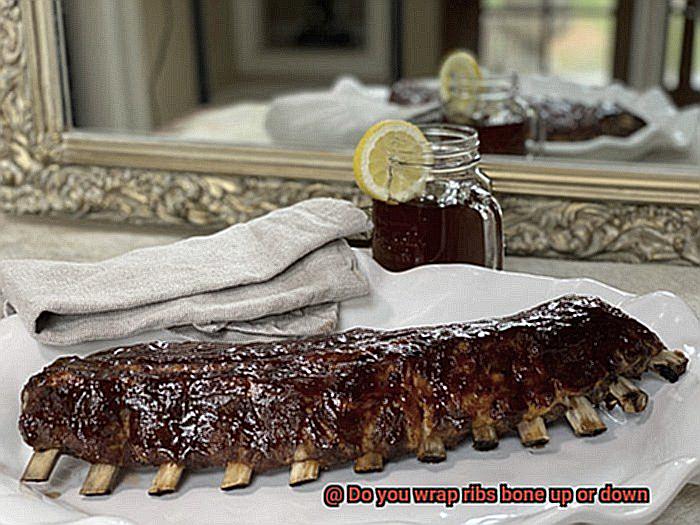
It’s important to experiment with both bone-up and bone-down methods to find what works best for you. Some grillers swear by one method over the other, but ultimately it comes down to personal preference and the specific cut of meat you’re working with.
Maintaining a consistent temperature throughout the cooking process is crucial. Avoid opening the grill too frequently as it can cause fluctuations in temperature and slow down cooking time.
Using high-quality barbecue sauce or marinade can help enhance the flavor of your ribs and give them a delicious caramelized coating.
Different Cooking Methods and Their Impact on Wrapping Ribs
If you’re a fan of ribs, you know that cooking them to perfection is an art form. Different cooking methods can yield vastly different results, and how you wrap your ribs can be crucial to their tenderness and flavor profile.
One popular method for cooking ribs is low and slow smoking. This technique involves cooking the meat at a low temperature over several hours, allowing the smoke to penetrate and infuse the meat with flavor. To keep your smoked ribs moist and tender, it’s essential to wrap them in foil or butcher paper. When wrapping smoked ribs, it’s best to place them bone side down so that the meat remains in contact with the wrapping material and absorbs the most moisture.
Grilling is another favored cooking method for ribs. Grilling can give your ribs a delicious charred flavor, but it can also dry out the meat if not done correctly. To prevent this from happening, it’s recommended to wrap your ribs in foil or butcher paper for a portion of the cooking time. When grilling, it’s best to place your ribs bone side up so that they don’t stick to the wrapping material and can easily be flipped during cooking.
If you prefer tender, melt-in-your-mouth ribs, braising might be the method for you. Braising involves simmering the meat in liquid for an extended period of time, breaking down connective tissue and resulting in a softer texture. When braising your ribs, it’s crucial to wrap them in foil or a covered roasting pan to retain moisture and enhance their flavor. In this case, wrapping your ribs bone side down is ideal so that they remain in contact with the liquid and absorb as much flavor as possible.
How to Prepare the Meat Before Wrapping
The key to achieving delicious and juicy ribs is proper meat preparation before wrapping. Here are five sub-sections explaining how to prepare the meat before wrapping ribs.
Trim the Meat
Before seasoning your ribs, it’s crucial to trim off any excess fat or connective tissue. These unwanted parts can cause the meat to become tough and chewy when cooked. Use a sharp knife or kitchen scissors to remove these parts from your ribs.
Season with a Dry Rub or Marinade
Season your ribs with a dry rub or marinade to enhance their flavor. A dry rub is a blend of spices that will create a crust on the outside of the meat. You can make your own or use store-bought rubs. Some popular spices include paprika, garlic powder, onion powder, cumin, and brown sugar. Apply the rub generously on both sides of the meat and let it sit for at least an hour before cooking.
Choose Your Wrapping Material
When it comes time to wrap your ribs, you can choose from foil, butcher paper, or banana leaves. Foil is a popular choice, but many people prefer butcher paper or banana leaves for added flavor. Whichever material you use, be sure to wrap your ribs tightly so that they cook evenly and retain moisture.
Cook to Temperature
Use a meat thermometer to check that your ribs have reached an internal temperature of at least 145°F (63°C) for food safety reasons. However, many people prefer their ribs to be cooked to a higher temperature (around 180°F or 82°C) for maximum tenderness and flavor. Be sure not to overcook your ribs as this will cause them to become dry and tough.
Rest and Serve
Once your ribs are cooked, let them rest for a few minutes before serving. This will allow the juices to redistribute and make the meat more flavorful. Cut the ribs into portions and serve with your favorite sides for a delicious meal.
Common Mistakes to Avoid When Wrapping Ribs
Get ready to tantalize your taste buds with the perfect rack of ribs. However, before you start cooking, it’s essential to know the common mistakes that people make when wrapping ribs. As an expert in this field, I’ll share some tips and tricks on how to avoid these pitfalls and ensure that your ribs are tender, juicy, and full of flavor.
Firstly, seasoning is key. It’s crucial to season your meat before wrapping it. A good dry rub or marinade will help enhance the natural flavors of the ribs and make them even more delicious. So, don’t be afraid to experiment with different flavor combinations.
The next mistake is using the wrong type of foil or wrap. Never compromise on quality. Use heavy-duty foil or butcher paper to prevent the meat from drying out or becoming too tough during the cooking process. A small investment in high-quality wraps can make a huge difference in the overall outcome.
Another critical factor to keep in mind is wrapping the ribs tightly. A loose wrap can allow air and moisture inside, leading to dry and tough meat. On the other hand, wrapping them too tightly can cause the meat to become overly tender and fall apart. So, ensure that you wrap them tightly but not too tight.
Finally, never underestimate the importance of letting your ribs rest after cooking. This step is often overlooked, but it’s crucial. Resting allows the juices in the meat to redistribute, making the ribs moist and tender when you finally take a bite.
O5M6iFHvTKs” >
Conclusion
In conclusion, the age-old debate of wrapping ribs bone up or down has been a hot topic among pitmasters for years. While there is no definitive answer, several crucial factors must be considered before making this decision. Personal preference, meat type, and cooking method are all essential components that can affect the outcome.
Wrapping ribs bone up provides a protective layer against direct heat and seals in the flavor, while wrapping them bone down prevents sticking and creates an attractive bark on your ribs. Experimenting with both methods is highly recommended to determine which works best for you.
Perfectly grilled ribs require proper preparation, seasoning, indirect heat, wrapping, and basting. Various cooking techniques such as low and slow smoking or grilling can also impact how you wrap your ribs.
To avoid common mistakes like using the wrong foil type or neglecting to let your ribs rest after cooking, attention to detail is critical. Following expert tips and tricks will ensure that you achieve mouth-watering fall-off-the-bone ribs that are sure to impress your guests.
In summary, mastering the art of wrapping ribs takes practice and experimentation.

